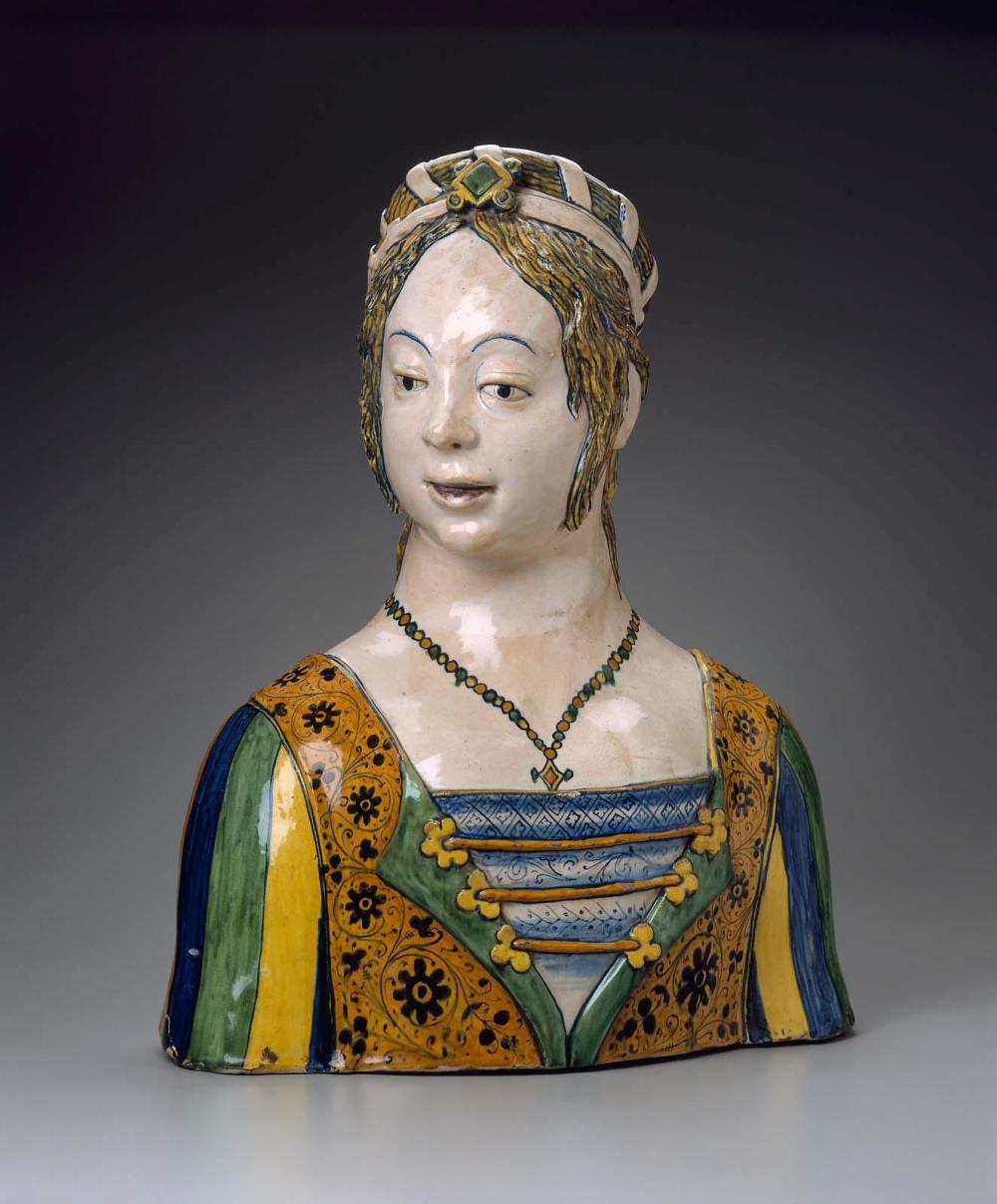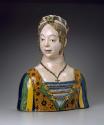Advanced Search
Bust of a woman
Italian (possibly Montelupo)
Renaissance
about 1490–1500
Medium/Technique
Tin-glazed earthenware (maiolica)
Dimensions
53.3 x 43.2 x 21.6 cm (21 x 17 x 8 1/2 in.)
Credit Line
William Francis Warden Fund
Accession Number54.146
NOT ON VIEW
CollectionsEurope
ClassificationsCeramics – Pottery – Earthenware
There are very few large-scale sculptures in maiolica, a material usually reserved for smaller vessels and plates. But here the characteristic colors of Renaissance pottery are used in a portrait bust of a young woman who wears bright, sumptuous clothes and jewels, characteristic dress for a young betrothed or recently married woman. The ambitious maker of this bust even tried to achieve realistic flesh tones in the glazes.
DescriptionHead turned slightly left, sleeves striped in green, blue and yellow. Yellow bodice with flowered ornament, painted necklace. White bandings in hair surround hole in top of head.
ProvenanceEmile Gavet (b. 1830 - d. 1904), Paris [see note 1]. Probably by 1907, J. Pierpont Morgan (b. 1837– d. 1913), London; 1916, sold from the Morgan collection to Duveen Brothers, Inc., London and Paris [see note 2]; 1932, shipped from Duveen, Paris, to Duveen, New York; 1954, sold by Duveen to the MFA for $12,000. (Accession Date: April 8, 1954)
NOTES:
[1] According to a letter from Bernard Rackham to Georg Swarzenski (May 24, 1955; in MFA curatorial file). This has not been verified.
[2] The bust was first published by Georg Swarzenski in Illustrierte Geschichte des Kunstgewerbes, vol. 1 (Berlin, 1907), pp. 512, 514, where it was said to be in London. It was probably already in the collection of J. Pierpont Morgan at this time. In a letter to Georg Swarzenski, Edward Fowles of Duveen (March 24, 1954; Duveen Brothers records, Getty Research Institute, Box 262, folder 18) writes that the bust "must have been one of the very early purchases by Mr. J. P. Morgan, Sr., and probably from Durlacher Brothers, from whom he purchased most of his early works of art. After Mr. Morgan, Sr.'s death, we bought the bust with the remainder of the Majolica Collection from the family, in 1916."
NOTES:
[1] According to a letter from Bernard Rackham to Georg Swarzenski (May 24, 1955; in MFA curatorial file). This has not been verified.
[2] The bust was first published by Georg Swarzenski in Illustrierte Geschichte des Kunstgewerbes, vol. 1 (Berlin, 1907), pp. 512, 514, where it was said to be in London. It was probably already in the collection of J. Pierpont Morgan at this time. In a letter to Georg Swarzenski, Edward Fowles of Duveen (March 24, 1954; Duveen Brothers records, Getty Research Institute, Box 262, folder 18) writes that the bust "must have been one of the very early purchases by Mr. J. P. Morgan, Sr., and probably from Durlacher Brothers, from whom he purchased most of his early works of art. After Mr. Morgan, Sr.'s death, we bought the bust with the remainder of the Majolica Collection from the family, in 1916."



